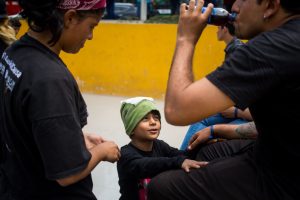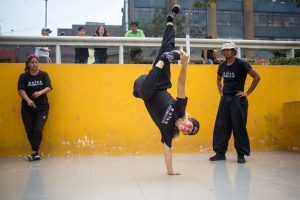By ANGELICA CABRAL
Cronkite Borderlands Project
LIMA, Peru – It’s evident from the way he imitates the dance crew’s moves that 5-year-old Christopher Diaz loves to dance, just like his father. But right now, Francisco Diaz isn’t dancing simply for the love of it – the Venezuelan immigrant is dancing to survive.
Like many others, Diaz left his home looking to support his growing family. He is among the more than 700,000 Venezuelans who have resettled in Peru hoping to better their lives in a country where challenges persist: 70% of Peru’s jobs are in the informal sector and 21% of the nearly 33 million residents live in poverty. Most of this migration to Peru has occurred over the past three or four years.
Diaz is among a growing group of immigrants who count on the arts to sustain them.
From singing on buses in poor parts of Lima to teaching classes in symphony halls, immigrants are using their talents to integrate and acculturate, as well as educate Peruvians about Venezuelans and their culture. Some, like Diaz, are working with the United Nations High Commissioner for Refugees (UNHCR) to nurture and develop artistic talent among refugees and asylum seekers.
In Venezuela, Diaz was a quadruple threat: disc jockey, master of ceremonies, dancer and graffiti artist. But with the birth of Christopher and the continued chaos in Venezuela, the income wasn’t enough.
“I started looking for two jobs,” he said. “One day I got tired of suffering because weeks had passed without eating … I told my wife I was going to go look for work outside of Venezuela because I couldn’t take the situation anymore.”
In Venezuela, Diaz initially had thought he might make a name in the skateboarding world, but he was turned off by all the partying and drugs. Hip-hop dancing, he said, was another world that many in Venezuela weren’t used to seeing. It was unique and entertaining and garnered attention.
“(People) looked at me weird because I was doing turns on the floor, I stood on my head,” he recalled. “So I wanted to inject the culture of hip-hop into the people of my land.”
He created an event with breakdancers from around Venezuela, which resulted in greater public acceptance, Diaz said. But it wasn’t paying the bills.
At first, he went to Colombia, where he could make enough money dancing on the street to survive. After three months, his wife and son joined him in Cucuta, and three months after that, they moved to Ecuador. But anti-immigrant feelings were high there, so they went to Peru.
“With the little that I made at the streetlight (in Cucuta), I could eat breakfast, lunch and dinner – all three of the meals,” said Diaz, who also could afford to send for his wife and son.
Inject Kulture, a street dancing group he founded back home, has now moved to Peru. Although it pays more than he could make at a regular job (Diaz says Peruvians take advantage of Venezuelan immigrants and want to pay them less), it seems it can’t last forever.
“Truthfully, we’re tired of being street dancers,” he acknowledged. “It’s hard work; the sun, one gets burned.”
He has plans for the future but needs to save money for now. He’d like to go back to Venezuela one day.
“It’s not the same as being in your house, your country, sharing with your friends,” Diaz said. “I think our job is to give a good message to the next generation of Venezuelans.”
The UNHCR effect
Diaz is working with UNHCR, which recently set up an office in Lima to deal with the mass migration to Peru. He even has met Angelina Jolie, a UNHCR ambassador, for a video they did for the UNHCR website to publicize the Venezuelan exodus. The UNHCR isn’t paying him, but Diaz hopes to establish a dance school with the help of Regina de la Portilla, the head of the UNHCR’s Lima office. For now, he’s still dancing in the streets.
De la Portilla said art is a way to help young refugees to feel included and integrated in their new society. Although the UNHCR’s art program is just starting in Peru, it has branches of the program worldwide. In Kenya, for example, the Artists for Refugees project aimed at developing the artistic and musical talents of refugees and asylum seekers, has sold 7,000 albums and 100 works of art.
A study done by VOX, the policy portal for the left-leaning Center for Economic and Policy Research, found that sharing information about immigrants can help shift people’s views and attitudes. The UNHCR is trying to do this with a program in which actors playing Venezuelan immigrants ride buses and deliver monologues. Afterward, the actors distribute pamphlets that dispel myths about Venezuelan immigrants by destigmatizing them.
For this endeavor, UNHCR has partnered with playwright Igor Olsen, who has been an immigrant twice.
Olsen left Peru for Venezuela when he was in his 20s at a time when his country was facing its own problems with political corruption, economic troubles and terrorism. Now 47 and a father, he has found history has repeated itself: he had to move back to Peru because of the economic and political chaos in Venezuela. The difference, Olsen said, is that Peru isn’t used to receiving immigrants the way Venezuela was.
For him, it was easy to feel Venezuelan; he said he even “thinks” Venezuelan. Olsen considers himself lucky that he chose to leave Peru decades ago instead of being forced to. Like many immigrants, his identity is split in half.
“There are a lot of things that I can’t negate in regard to my (Peruvian side) that I like, but there are other things that are important that have to do with my character and way of understanding the world that are directly related with Venezuela,” he said.
Olsen is writing the bus monologues the UNHCR actors. They follow a story similar to his: people who had to leave Peru and then came back. Olsen describes the bus performances as interventions.
“I think art is a stupendous channel for people to understand what happens in the towns,” Olsen said. “The penetration of the Venezuelan artistic world in Lima is very important.”
The singer
Witter Garcia Olavarrieta wants to be known for his voice. In his native Venezuela, he once competed for several weeks on a national television show.
But since moving to Peru, he has been relegated to working the buses, at first selling items to make a few soles and then singing for money. He said the singing went a bit better, but it was far from easy money.
“When I was working in the bus, there were moments that they treated me badly,” he recalled. “You got on, you stood there, and just standing there, you were afraid to say anything.”
People would make derogatory comments, which he tried to laugh it off even though it bothered him.
He graduated in 2017 from college in Venezuela with a degree in social communications but left the country five months after finishing school. In Lima, a group of Venezuelan performers that he knew from home reached out and they now perform together. On a warm Saturday night in early March, at a chain restaurant called Villa Chicken, they covered popular songs from Santana to Selena. Olavarrieta also gives dance classes to make money
Olavarrieta has been singing in festivals and school events since he was 8, and his mother and sister sing as well.
“I carry it in my blood,” he said.
In Venezuela, he was on a TV show called Generation Ese for five weeks. That required a 10-hour round trip every week from Barquisimeto to Caracas, where he stayed with a friend for a few nights. He says it was all worth it.
In Peru, he managed to get on a television show called Yo Soy, an imitation singing competition, at the encouragement of friends. After waiting for 11 hours in line the first day and 10 hours the next, he performed as Ricky Martin.
“In the end, it’s like a window that you open yourself,” Olavarrieta said. “I took it like a window for the world to see me, but my objective is not that, my objective is to be known as Witter.”
He dearly misses his family and has a special connection with his mother..
“I think that where I am now, I’m good because I’ve learned to be a better person,” Olavarietta said. “I’ve learned to value things. Before I didn’t value things because my mom just gave them to me.”
He hopes conditions will improve in Venezuela.
“We are waiting,” he said. “All the world is there, waiting. They’re in a waiting that never ends. It makes me really sad.”
The cellist
Liliana González learned English from watching the Hollywood blockbuster Titanic, and she laughs easily as she imitates Jack calling to Rose in the frigid waters. In addition to her storytelling skills, she’s a talented cellist who has trained since age 10.
She said she was raised in a dysfunctional family that experienced domestic violence, and she grew up not knowing how to treat people. But music opened a whole new world.
“I liked music. I didn’t know (how to play), but I simply saw a piano and hearts came out of me,” she said.
González, who now teaches music at the Colegio de Merced in Lima, got a break with the help of a friend, Alfredo Rebaza of the Cultural Center at the Feminine University of the Sacred Heart. He arranged an interview with the director of the college, who offered her the job.
But González hadn’t gotten the temporary residency permit that Peru used to issue to Venezuelans allowing them to work, and it appeared the college would hire someone else. But the other candidate didn’t work out, and by that time, González had gotten her work permit and the job was hers.
The food in Lima, especially the ceviche, has González happy in her new life. But she finds it hard to confide in Peruvians because she doesn’t know whether they will be accepting.
“I came here with knots (in my throat) because I didn’t know how they were going to receive me,” González said. “One thing is what you see on the internet and another is what you live. … As soon as you get here, everyone notices that you’re different.”
She hopes to become a part of Peruvian society as a musician, but her ultimate goal is to return home to her family in Venezuela.
“When you’re an immigrant, you leave behind dreams to have a future,” González said. “It has to be that it was worth it for me to have left, that it was worth it these days, these months, without seeing my family.”
Cronkite Borderlands Project is a multimedia reporting program in which students cover human rights, immigration and border issues in the U.S. and abroad in both English and Spanish.
For more stories from Cronkite News, visit cronkitenews.azpbs.org.
^_=




